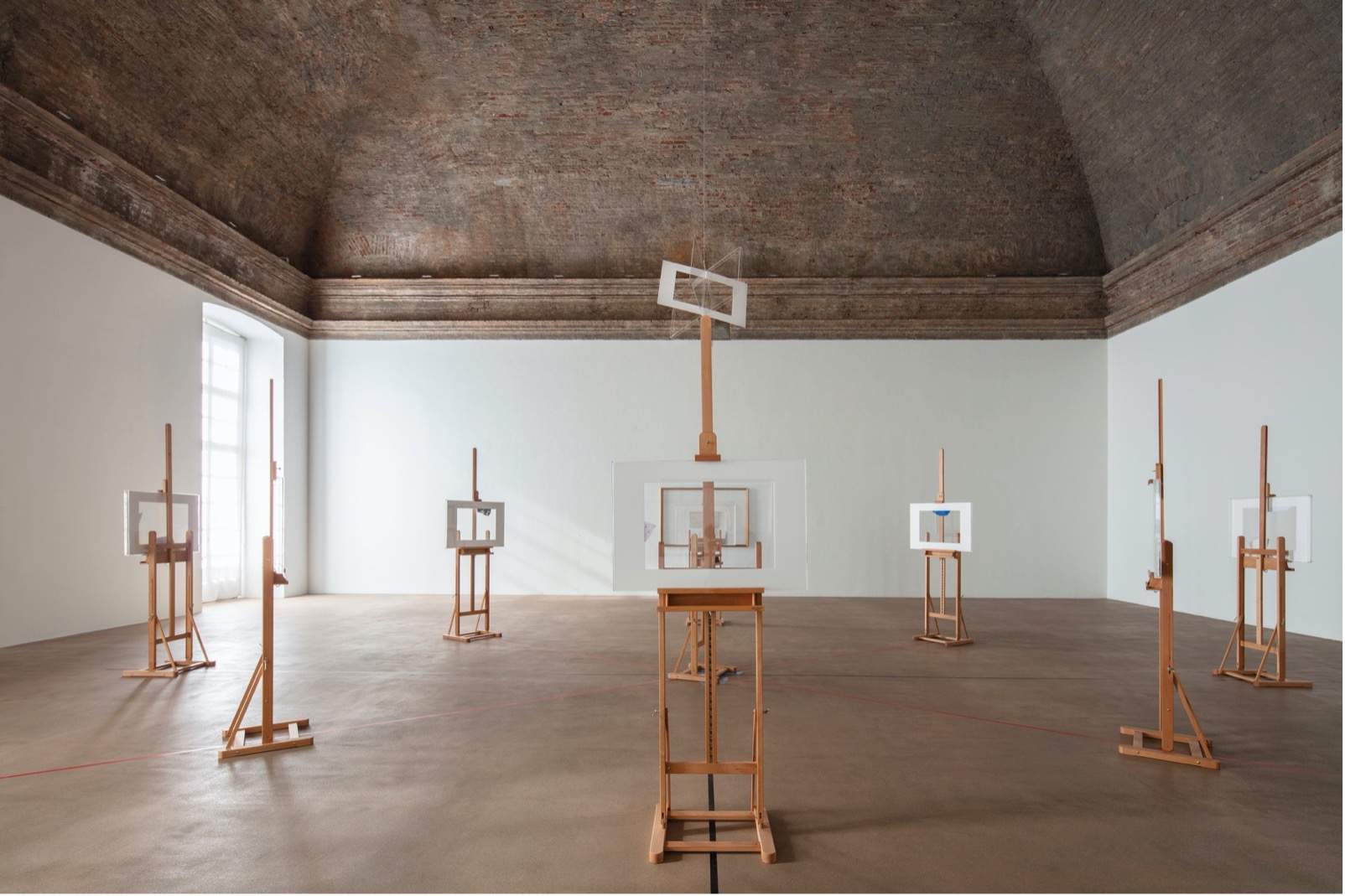Giulio Paolini donates his work "Le Chef-d'œuvre inconnu" to Castello di Rivoli
On the occasion of his solo exhibition at the Castello di Rivoli, Giulio Paolini (Genoa, 1940) donated to the museum the large installation Le Chef-d’œuvre inconnu, a work from 2020 that welcomes visitors in Room 18. The installation, which thus becomes part of the museum’s permanent collection, takes its starting point from Geometric Drawing, 1960, one of the artist’s most important works. The title refers to the squaring of the canvas, the painter’s first act. Geometric Drawing is a rectangular canvas painted white, on which Paolini “chose to copy, in the right proportion, the preliminary design of any drawing, that is, the geometric squaring of the surface” (read also our recent interview with the artist).
In the room on the second floor of the Residenza Sabauda, the long lines marked on the ground correspond to the trace of the medians and diagonals of Geometric Drawing, while each of the eight squaring points is marked by the presence of a painting easel with a transparent shrine. Each theca houses paper fragments of sketches and cuttings from the artist’s studio in Turin. Hanging from above and installed in the center of the room defined by a ninth empty easel is an additional vitrine, whose presence brings the number of vitrines and related easels in the installation to nine. "Visiting the large installation Le Chef-d’œuvre inconnu," writes curator Marcella Beccaria, “is like walking among Giulio Paolini’s ideas and seeing them take shape before our eyes. The presence of this work in the collection allows Castello di Rivoli to document the artist’s fundamental journey, from his beginnings in the Arte Povera movement to the present.”
In addition, to celebrate the finissage of the exhibition, on Sunday, May 16, 2021, at 12 noon, Castello di Rivoli is organizing a meeting at which the exhibition catalog will be presented in the presence of the artist, the museum’s director, Carolyn Christov-Bakargiev, and the exhibition’s curator, Marcella Beccaria. The important publication is divided into two volumes: volume I, Giulio Paolini. “Le Chef-d’œuvre inconnu” recounts the exhibition through new essays by Carolyn Christov-Bakargiev and Marcella Beccaria and images of the works on display. The scholarly apparatus documents the artist’s exhibition history at Castello di Rivoli. Volume II, Giulio Paolini. Recitals. Writings in Verse 1987-2020 focuses on the artist’s verses, introduced by a new text by Andrea Cortellessa. Giulio Paolini designed the graphic design for the covers of the two volumes and conceived the new work Untitled, 2020, for the inside of the dust jacket.
Giulio Paolini, born November 5, 1940 in Genoa, resides in Turin and is one of the most important Italian artists of recent years. His poetics revolves around themes that question the conception, manifestation and vision of the work of art. From his first investigations around the constituent elements of the painting, his attention later turned to the act of exhibition, the consideration of the work as a catalog of its own possibilities, as well as the figure of the author and his lack of contact with the work, which pre-exists and transcends him.
Since his first participation in a group exhibition (1961) and his first solo show (1964), he has held numerous exhibitions in galleries and museums around the world. Major anthological exhibitions include those at the Palazzo della Pilotta in Parma (1976), the Stedelijk Museum in Amsterdam (1980), the Nouveau Muséand of Villeurbanne (1984), at the Staatsgalerie in Stuttgart (1986), at the Galleria Nazionale d’Arte Moderna in Rome (1988), at the Neue Galerie am Landesmuseum Joanneum in Graz (1998), at the GAM Galleria Civica d’Arte Moderna e Contemporanea, Turin (1999), at the Fondazione Prada in Milan (2003), at the Kunstmuseum in Winterthur (2005), at the MACRO Museo d’Arte Contemporanea Roma (2013) and at the Whitechapel Gallery in London (2014). Recent solo shows include those at the Center for Italian Modern Art in New York (in dialogue with works by Giorgio de Chirico, 2016) and at the Fondazione Carriero in Milan (2018). He participated in several Arte Povera exhibitions and was invited several times to the Kassel Documenta (1972, 1977, 1982, 1992) and the Venice Biennale (1970, 1976, 1978, 1980, 1984, 1986, 1993, 1995, 1997, 2013). Since 1969, he has also created sets and costumes for theatrical performances, among which are the projects conceived with Carlo Quartucci in the 1980s and the sets for two operas by Richard Wagner at the Teatro di San Carlo in Naples directed by Federico Tiezzi (2005, 2007).
A graphic designer by training, he has always had a special interest in the editorial field and the written page. From the beginning he has accompanied his artistic research with reflections collected in books he has edited himself: from Idem, published in 1975 by Einaudi with an introduction by Italo Calvino, to the recent Quattro passi. Nel museo senza muse (Einaudi, Turin 2006), Dall’Atlante al Vuoto in ordine alfabetico (Electa, Milan 2010) and L’autore che credeva di esistere (Johan & Levi, Milan 2012). There are numerous publications dedicated to his artistic production: from Germano Celant’s first monograph (Sonnabend Press, New York 1972) to Francesco Poli’s volume (Lindau, Turin 1990), to the catalog raisonné of works dated from 1960 to 1999, edited by Maddalena Disch (Skira Editore, Milan 2008).
In the photo: Giulio Paolini. Le Chef-d’œuvre inconnu (2020; easels, Plexiglas cases, collage on passe-partout, torn photographic reproduction, red tape and black tape on floor, gold frames, pencil on wall, environmental measurements; Rivoli, Castello di Rivoli Museo d’Arte Contemporanea). Photo by Agostino Osio, Milan
 |
| Giulio Paolini donates his work "Le Chef-d'œuvre inconnu" to Castello di Rivoli |
Warning: the translation into English of the original Italian article was created using automatic tools. We undertake to review all articles, but we do not guarantee the total absence of inaccuracies in the translation due to the program. You can find the original by clicking on the ITA button. If you find any mistake,please contact us.





























